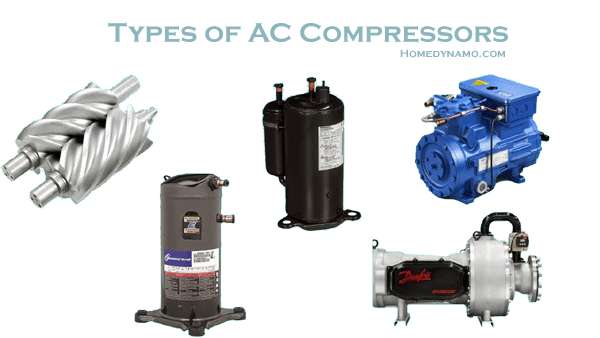The compressor is an important component of an air conditioner. It is responsible for increasing the temperature and pressure of vapor refrigerant, which leaves the evaporator coil.
The compressor increases the vapor refrigerant pressure to create a pressure difference, to ensure the refrigerant flows – high pressure fluids move towards low-pressure fluids. Technically, the compressor raises the pressure so that the refrigerant flows to the low-pressure refrigerant.

Besides, the compressor is also responsible for increasing temperature. Heat flows from a high temperature substance to a low temperature substance. The hot substance is present in the condenser and compressor and the low temperature substance is in the evaporator coil.
How Does an Air Conditioner Compressor Work?
There are actually 5 different types of Air Conditioning compressors and the functioning of each type of compressor differs from one another. So, let us look at each compressor type separately.
- Reciprocating Compressor
- Scroll Compressor
- Rotary Compressor
- Screw Compressor
- Centrifugal Compressor
1. Reciprocating AC Compressor
It is the most preferred AIR CONDITIONER compressor. It works with the help of a piston compressing the air by moving up and down within the cylinder. When the piston moves upwards, it creates a vacuum effect, which sucks the refrigerant in. As the piston moves up, gas compresses and moves directly into the condenser.
Reciprocating the air conditioner compressor is an efficient component. Air Conditioning units can have eight cylinders inside the compressor.
This type of compressor has multiple functions as described below:
- Re-expansion: The compressor motor starts turning and the piston moves down into the cylinder. The piston does down, increases the volume of space, in which the refrigerant is. In addition, pressure starts decreasing due to the amount of refrigerant already present in that large space. Hence, the refrigerant expands. As the refrigerant expands, the process is known as re-expansion.
- Suction: The refrigerant’s pressure drops continuously until it is lower than the suction pressure of the system. The low pressure side of the system is called the suction pressure. At that stage, the suction pressure is greater than the compression chamber and the suction valve opens. The piston continues to move downward and the suction gas draws into the compression chamber. The suction continues until the piston stops moving in a downward direction. As the piston reaches the lowest point inside the cylinder, which is the bottom dead center, suction ends.
- Compression: The compressor continues operations and the piston starts moving upwards. The upward motion pushes the suction valve closed, thus trapping the refrigerant within the cylinder and increasing the refrigerant pressure. Compression continues until the pressure of the cylinder is more than the refrigerant pressure in the line of discharge.
- Discharge: When the pressure of the cylinder is more than the discharge pressure, it is likely that the discharge valve would push upwards, thus allowing the high pressure refrigerant to be further pushed out of the cylinder and into the line of discharge with the piston moving upwards continuously. Discharge continues until the piston reaches its top dead center. At that same spot, the discharge refrigerant pushes the discharge valve closed and the piston starts moving downwards.
2. Scroll Air Conditioner Compressor
Scroll Air Conditioning compressors are relatively new on the market. They have a fixed coil, which is the scroll, right at the center of the unit, and a second coil rotating around it.
In the process, the second scroll gently pushes the refrigerant towards its center to create compression.
Scroll compressors are becoming popular, as they do not contain too many moving parts. Hence, they are more reliable.
3. Rotary AC Compressor
Rotary compressors are smaller compared to both the aforementioned ones and relatively quieter too. They are the popular choice in Air Conditioners where noise could be a concern. The inner part of this type of compressor contains a shaft with multiple blades.
The bladed shaft rotates inside the air conditioner’s graduated cylinder, pushing the refrigerant through the cylinder and compresses simultaneously.
4. Screw Air Conditioning Compressor
The screw air conditioner compressor is an efficient and reliable one. However, it is primarily used in larger buildings where there is more air, which requires consistent cooling.
Screw air conditioning compressor has two large helical rotors moving the air from end to end.
As the refrigerant moves through the compressor, space becomes smaller, and it is easily compressed.
5. Centrifugal AC Compressor
The centrifugal compressor is primarily used to cool larger space with vast air capacity. A unique compressor utilizes centrifugal force. It does not have too many moving parts apart – no piston, valve, blades, or cylinder. It is highly efficient and reliable at high speeds.
The impeller, which is a disk having radial blades, sucks the refrigerant gas. The impeller, then, spins rapidly within the housing compartment. Consequently, the refrigerant gains velocity within the system and is compressed as it reaches the terminal velocity at the impeller’s outside edge. Finally, it is released into the air conditioning condenser.
As you are fully aware of all types of air conditioning compressors, you are free to choose any of some types that would serve your requirements in terms of efficiency and reliability.
